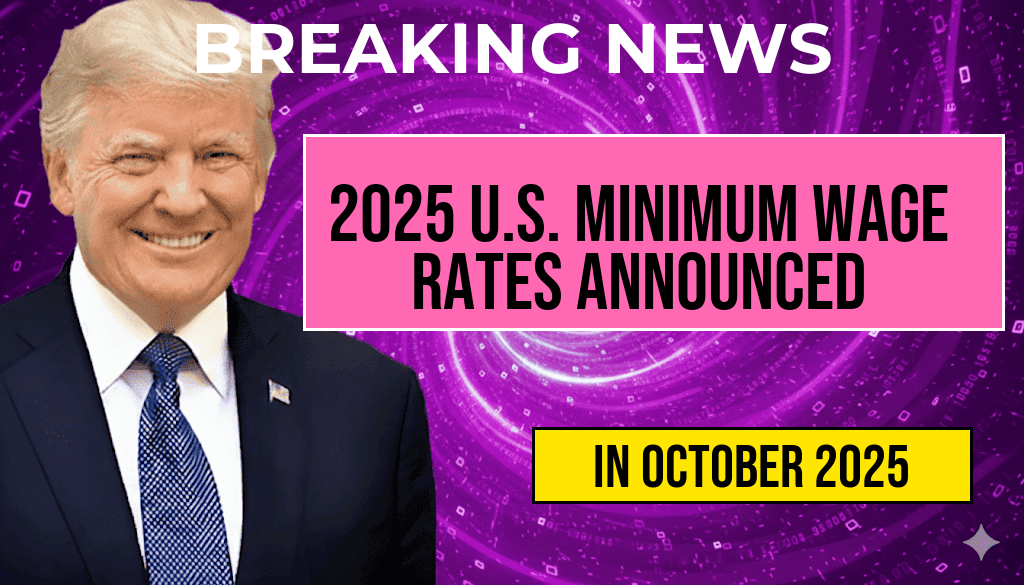The U.S. Department of Labor announced on October 4 that the hourly pay rates for the federal minimum wage will increase in 2025, a significant adjustment aimed at improving the living standards for low-wage workers across the nation. The new rates will take effect on January 1, 2025, when the federal minimum wage will jump to $15 per hour, up from the current rate of $12. The adjustment reflects ongoing efforts to address inflation and the rising cost of living, which have disproportionately affected low-income families. This change has sparked discussions among economists, labor advocates, and business owners about its potential impacts on the economy and job market.
Details of the Minimum Wage Increase
The increase to $15 per hour represents a critical step in the federal government’s commitment to ensuring a more equitable wage structure. The Department of Labor’s announcement outlines the following key points regarding the upcoming changes:
- The federal minimum wage will rise to $15 per hour starting January 1, 2025.
- This marks an increase of $3 from the current minimum wage of $12.
- The increase aligns with a broader movement across many states and cities that have implemented higher minimum wages.
Impact on Workers and Businesses
Labor advocates have praised the increase as a necessary measure to combat poverty and support working families. Studies have shown that raising the minimum wage can lead to improved health outcomes, reduced reliance on social services, and increased consumer spending, which can stimulate local economies. However, opponents argue that such increases may lead to job losses, as businesses may struggle to cover higher labor costs.
For small businesses, the adjustment could pose challenges. Many owners express concerns about their ability to maintain profitability while paying higher wages. Some businesses may need to raise prices for consumers or reduce employee hours, which could negate some of the benefits of the wage increase.
State-Level Reactions
Reactions to the announcement vary significantly across states. Some states have already enacted minimum wage increases that exceed the federal rate, while others have yet to align their policies with the upcoming federal standard. Notable state-level responses include:
- California: With a current minimum wage of $15.50, California is already ahead of the federal increase.
- New York: The state plans to raise its minimum wage to $16 by 2025, following its existing trajectory.
- Texas: Currently at $7.25, Texas has not scheduled any increases, which has raised concerns among labor groups.
Economic Implications
The economic implications of the minimum wage increase are complex. Proponents argue that higher wages can lead to increased consumer spending, which benefits the overall economy. However, some economists warn that sudden increases in labor costs may lead to inflationary pressures, as businesses pass on costs to consumers.
Moreover, the potential for reduced employment opportunities remains a point of contention. According to a study by the Economic Policy Institute, states that have implemented gradual minimum wage increases have generally not experienced significant job losses. However, the debate continues, with many stakeholders closely monitoring the impact of the federal increase.
Conclusion
The announcement of an increase to the federal minimum wage in 2025 marks a pivotal moment in U.S. labor policy, reflecting ongoing debates about economic equity and workers’ rights. As the effective date approaches, the implications for workers, businesses, and the economy will be closely scrutinized. The adjustments to pay rates are expected to influence discussions around living wages and economic sustainability for the foreseeable future.
| Year | Minimum Wage Rate |
|---|---|
| 2023 | $12.00 |
| 2024 | $12.00 |
| 2025 | $15.00 (Effective January 1) |
For more information on the minimum wage increase and its implications, you can visit the U.S. Department of Labor website.
Frequently Asked Questions
What is the new minimum wage rate announced for 2025?
The new minimum wage rate for 2025 has been set to $15.00 per hour, reflecting the ongoing efforts to ensure fair compensation for workers across various sectors.
When was the minimum wage increase announcement made?
The announcement regarding the minimum wage increase was made on October 4, 2023, providing clarity for employers and employees alike.
How will the minimum wage increase impact workers?
The increase in the minimum wage is expected to enhance the financial stability of low-wage workers, allowing them to better meet their living expenses and improve their quality of life.
Are there any exceptions to the new minimum wage rates?
Yes, certain categories of workers, such as tipped employees or those under specific training programs, may have different minimum wage requirements, which can vary by state.
What should employers do in preparation for the minimum wage increase?
Employers should review their payroll systems, update employee compensation structures, and ensure compliance with the new minimum wage regulations by the effective date.

Leave a Reply